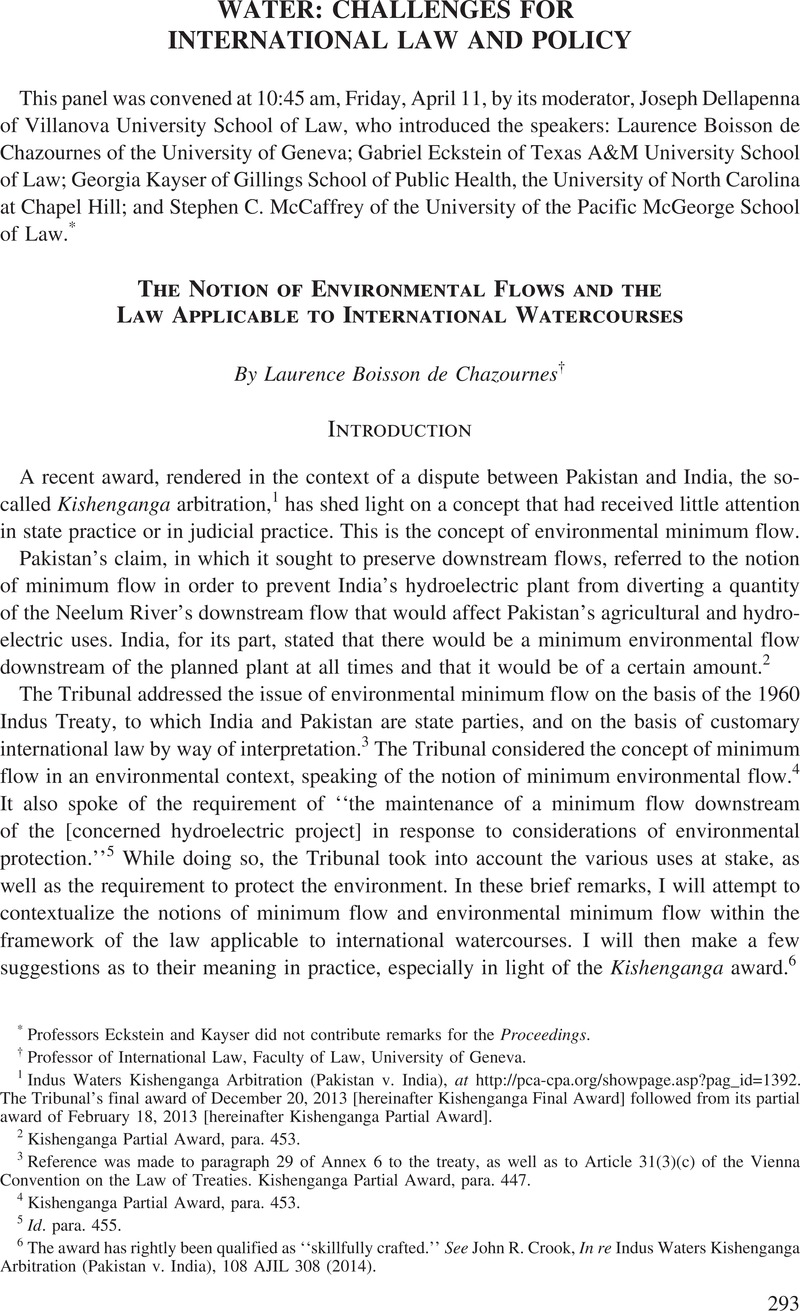No CrossRef data available.
Article contents
The Notion of Environmental Flows and the Law Applicable to International Watercourses
Published online by Cambridge University Press: 20 January 2017
Abstract

Information
- Type
- Water: Challenges for International Law and Policy
- Information
- Copyright
- Copyright © American Society of International Law 2015
References
* Professors Eckstein and Kayser did not contribute remarks for the Proceedings.
1 Indus Waters Kishenganga Arbitration (Pakistan v. India), at http://pca-cpa.org/showpage.asp?pag_id=1392. The Tribunal’s final award of December 20, 2013 [hereinafter Kishenganga Final Award] followed from its partial award of February 18, 2013 [hereinafter Kishenganga Partial Award].
2 Kishenganga Partial Award, para. 453.
3 Reference was made to paragraph 29 of Annex 6 to the treaty, as well as to Article 31(3)(c) of the Vienna Convention on the Law of Treaties. Kishenganga Partial Award, para. 447.
4 Kishenganga Partial Award, para. 453.
5 Id. para. 455.
6 The award has rightly been qualified as “skillfully crafted.” See Crook, John R., In re Indus Waters Kishenganga Arbitration (Pakistan v. India), 108 AJIL 308 (2014)Google Scholar.
7 UN Convention on the Law of the Non-Navigational Uses of International Watercourses, art. 11, May 21, 1997, ILM 36 (1997) [hereinafter UN Watercourses Convention].
8 See Commentary to Article 11 of the Draft Articles (which later became the UN Watercourses Convention), in Report of the International Law Commission—Forty-Sixth Session, UN Doc. A/49/10, 111 (1994) [hereinafter ILC Report].
9 The ILC has explained that in case of conflict among different uses:
… in deciding upon the manner in which such a conflict is to be resolved, watercourse States are to have ‘special regard … to the requirements of vital human needs’. That is, special attention is to be paid to providing sufficient water to sustain human life, including both drinking water and water required for the production of food in order to prevent starvation. This criterion is an accentuated form of the factor contained in article 6, paragraph 1 (b), which refers to the ‘social and economic needs of the watercourse States concerned’.
For further details, see ILC Report, supra note 8, at 110.
10 Laurence Boisson de Chazournes, Fresh Water in International Law 119–23 (2013).
11 Id. at 24–25.
12 Treaty on the Lesotho Highlands Water Project Between the Government of the Kingdom of Lesotho and the Government of the Republic of South Africa, art. 6(9), Oct. 24, 1986, at http://www.fao.org/docrep/W7414B/w7414b0w.htm.
13 Agreement on the Cooperation for the Sustainable Development of the Mekong River Basin, art. II(3), Apr. 5, 1995, ILM 34 (1995).
14 Id. art. II(1).
15 Water Charter of the River Niger Basin, art. 11(1) (2008). See discussion in Christina Leb, Cooperation in the Law of Transboundary Water Resources 172–74 (2013).
16 Resolution VIII.1, Guidelines for the Allocation and Management of Water for Maintaining the Ecological Functions of Wetlands, para. 28 (Nov. 18–26, 2002).
17 See Treaty Concerning the Integrated Development of the Mahakali River, art. 1(2), Feb. 12, 1996, ILM 36 (1996).
18 Lake Lanoux Case (France v. Spain), § 6 at 19, 12 R.I.A.A. 281; 24 I.L.R. 101 (1957):
none of the guaranteed users will suffer in his enjoyment of the waters (this is not the subject of any claim founded on Article 9); at the lowest water level, the volume of the surplus waters of the Carol, at the boundary, will at no time suffer a diminution; it may even, by virtue of the minimum guarantee given by France, benefit by an increase in volume assured by the waters of the Ariege flowing naturally to the Atlantic.
19 Gabčíkovo-Nagymaros Project (Slovakia/Hungary), 1997 ICJ Rep. 7, para. 55.
20 Id. para. 40.
21 Id. para. 55.
22 Kishenganga Partial Award, para. 452.
23 Id. para. 454.
24 Pulp Mills on the River Uruguay (Argentina v. Uruguay), 2010 ICJ Rep. 83.
25 Kishenganga Partial Award, para. 450.
26 Id. para. 449.
27 Id. para. 450.
28 Gabčíkovo-Nagymaros Project (Hungary/Slovakia), 1997 ICJ Rep. 7, 78.
29 Kishenganga Partial Award, para. 454.
30 Kishenganga Final Award, part. V, p. 43.
31 Id. paras. 104–14.
32 McCaffrey, Stephen C., Some Developments in the Law of International Watercourses, in Promoting Justice, Human Rights and Conflict Resolution Through International Law: Liber Amicorum Lucius Caflisch 785 (Kohen, Marcelo G. ed., 2007)Google Scholar.
33 Kishenganga Partial Award, para. 455.

